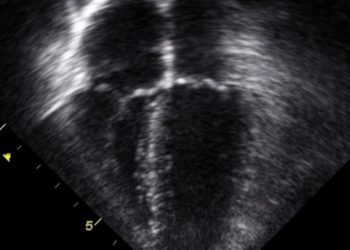High BMI in children is associated with known risk factors of cardiovascular disease
Image: PD
Key Study Points:
- Obese children and adolescents have several risk factors for cardiovascular disease including elevated blood pressure, cholesterol, fasting glucose and insulin, and an increase in left ventricular mass.
- These risk parameters of cardiovascular disease are greatest in obese children suggesting that they may also have a larger disease burden in adulthood if risk factors are not addressed early on.
Primer: The World Health Organization states that in 2010 more than 42 million children under the age of 5 were overweight with nearly 35 million of them living in developed nations. Hence, childhood obesity is one of the greatest health challenges of the 21st century. It has been well documented that adults who are overweight or obese are at an increased risk of cardiovascular disease, but the effects of childhood obesity and increased weight on the development of cardiovascular disease risk factors in childhood are not as well-delineated. In this study, a systematic review and meta-analysis were performed to examine the significance of the correlation between body mass index and risk factors of cardiovascular disease in children.
Background reading:
-
Juhola J, et al. Tracking of serum lipid levels, blood pressure, and body mass index from childhood to adulthood: the Cardiovascular Risk in Young Finns Study. J Pediatr 2011;159:584-90.
-
Kavey R et al. Expert panel on integrated guidelines for cardiovascular health and risk reduction in children and adolescents: summary report. Pediatrics 2011;S213-56.
-
World Health Organization. Obesity and overweight factsheet number 311. www.who.int/mediacentre/factsheet/fs311/en/index.html
This [systematic review and meta-analysis]: The review and meta-analysis utilized of 63 studies that included a total of 49,220 healthy children aged 5-15 years of age from 42 highly developed countries. Both systolic and diastolic blood pressure measurements were markedly increased in overweight (4.54/2.57mg Hg) and obese (7.49/4.06 mg Hg) children when compared to normal weight children. Total cholesterol was significantly elevated in all obese children but not in overweight children. Also, HDL cholesterol was reduced in overweight (6.56 mg/dl) and obese children (8.48 mg/dl). In terms of fasting glucose, insulin, and insulin resistance, only obese children had significant increases in all of these parameters. Fasting insulin was found to be twice as high in obese versus normal weight children than in overweight versus normal weight children. Finally, obesity was also associated with an increase in height-adjusted left ventricular mass.
In sum: This study was a large multi-national meta-analysis that looked at the correlation between body mass index, sex, and risk factors of cardiovascular disease in children. The authors concluded that having an increased body mass index is associated with an increased likelihood of developing risk factors of cardiovascular disease. This would include increases in blood pressure, cholesterol, and fasting glucose and insulin. Without preventative measures, these findings would also potentially mark these children to have increased risk of cardiovascular risk as an adult with increased risk of cardiovascular disease, diabetes and stroke.
There were several limitations to the study. As a review and meta-analysis, there was a lack of standardization of methods across studies. Furthermore, the effect of age and pubertal status could not be tracked due to insufficient reporting from most studies. In addition, with a population drawn from developed nations, generalizability on the global scale remains to be seen and may require further study. Finally, while the authors argue that the implications of these findings may indeed be particularly important in tracking to adulthood, the analyzed studies did not specifically investigate this link. Nonetheless, in the setting of dramatic increases in childhood obesity, this meta-analysis speaks to the need of further research and better delineation of the relationship of BMI with associated cardiovascular risk, including the investigation of the effectiveness of interventions aimed at children with the objective of reducing morbidity and mortality in adulthood.
Click here to read article in BMJ
By BH and RR
© 2012 2minutemedicine.com. All rights reserved. No works may be reproduced without written consent from 2minutemedicine.com. DISCLAIMER: Posts are not medical advice and are not intended as such. Please see a healthcare professional if you seek medical advice.





